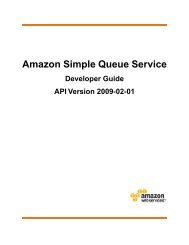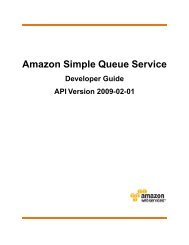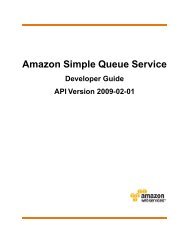sqs-dg-2009-02-01
Create successful ePaper yourself
Turn your PDF publications into a flip-book with our unique Google optimized e-Paper software.
Amazon Simple Queue Service Developer Guide<br />
Shared Queues<br />
Shared Queues<br />
Topics<br />
• Simple API for Shared Queues (p. 29)<br />
• Advanced API for Shared Queues (p. 29)<br />
• Understanding Permissions (p. 29)<br />
• Granting Anonymous Access to a Queue (p. 30)<br />
Amazon SQS includes methods to share your queues so others can use them, using permissions set in<br />
an access control policy. A permission gives access to another person to use your queue in some particular<br />
way. A policy is the actual document that contains the permissions you've granted.<br />
Amazon SQS offers two methods for setting a policy: a simple API and an advanced API. In the simple<br />
API, SQS generates an access control policy for you. In the advanced API, you create the access control<br />
policy.<br />
Simple API for Shared Queues<br />
The simple API for sharing a queue has two operations:<br />
• AddPermission<br />
• RemovePermission<br />
With the Simple API, Amazon SQS writes the policy in the required language for you based on the<br />
information you include in the AddPermission operation. However, the policy that Amazon SQS generates<br />
is limited in scope. You can grant permissions to principals, but you can't specify restrictions.<br />
Advanced API for Shared Queues<br />
With the advanced API, you write the policy yourself directly in the access policy language and upload<br />
the policy with the SetQueueAttributes operation. The advanced API allows you to deny access or to<br />
apply finer access restrictions (for example, based on time or based on IP address).<br />
If you choose to write your own policies, you need to understand how policies are structured. For complete<br />
reference information about policies, see Using The Access Policy Language (p. 32). For examples of<br />
policies, see Amazon SQS Policy Examples (p. 57).<br />
Understanding Permissions<br />
A permission is the type of access you give to a principal (the user receiving the permission). You give<br />
each permission a label that identifies that permission. If you want to delete that permission in the future,<br />
you use that label to identify the permission. If you want to see what permissions are on a queue, use<br />
the GetQueueAttributes operation. Amazon SQS returns the entire policy (containing all the permissions).<br />
Amazon SQS supports the permission types shown in the following table.<br />
Permission<br />
*<br />
ReceiveMessage<br />
Description<br />
This permission type grants the following actions to a principal on a shared<br />
queue: receive messages, send messages, delete messages, change a<br />
message's visibility, get a queue's attributes.<br />
This grants permission to receive messages in the queue.<br />
API Version <strong>2009</strong>-<strong>02</strong>-<strong>01</strong><br />
29






